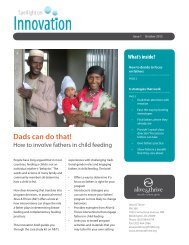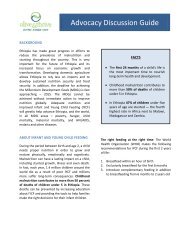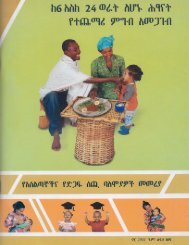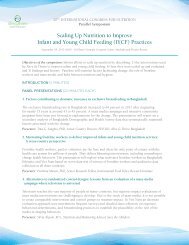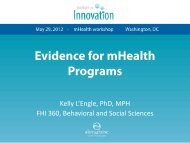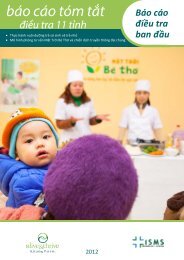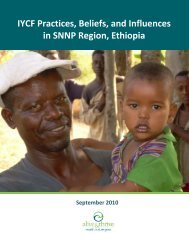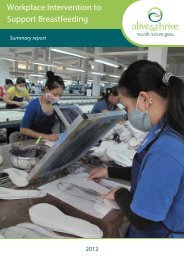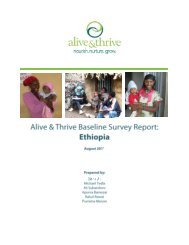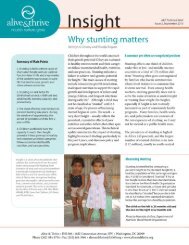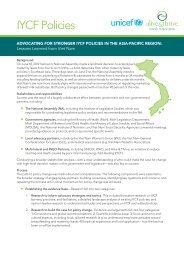IYCF Practices, Beliefs, and Influences in Tigray ... - Alive & Thrive
IYCF Practices, Beliefs, and Influences in Tigray ... - Alive & Thrive
IYCF Practices, Beliefs, and Influences in Tigray ... - Alive & Thrive
Create successful ePaper yourself
Turn your PDF publications into a flip-book with our unique Google optimized e-Paper software.
The health status of children <strong>in</strong> the three communities was associated with the food they eat <strong>and</strong> the<br />
economic status of the family. Some mothers mentioned that children from well-to-do families are fed<br />
well, while children from poor families are not gett<strong>in</strong>g adequate types <strong>and</strong> amounts of food. It was also<br />
said dur<strong>in</strong>g the FGDs that growth of children is dependent on the family’s economic status <strong>and</strong> whether<br />
they own cattle or chicken. Study participants considered children from “rich” families to have better<br />
access to cow’s milk <strong>and</strong> eggs, whereas those from poor families have to rely on the commonly given<br />
food items like unleavened bread, <strong>in</strong>jera, <strong>and</strong> chibito.<br />
“Children of this community are not grow<strong>in</strong>g healthy <strong>and</strong> strong due to lack of<br />
different types of foods, clean <strong>and</strong> safe water, poor hygiene <strong>and</strong> <strong>in</strong>accessibility of<br />
health facility.” (A mother from Tahitay Macho)<br />
“Everyth<strong>in</strong>g is accord<strong>in</strong>g to what you have. If you are rich enough, you will feed<br />
your child very well <strong>and</strong> if not children can’t be fed well. If you have it, you will<br />
feed the child porridge, gruel, <strong>and</strong> cow’s milk. So children <strong>in</strong> the community are<br />
grow<strong>in</strong>g based on what they have. If we don’t attend to their hygiene, they will be<br />
sick. If we treat them well <strong>and</strong> keep up their hygiene, they grow well.” (A mother<br />
from Raya Azebo)<br />
Hygiene <strong>and</strong> immunization were also mentioned as factors that affect children’s health status. The FGD<br />
participant fathers <strong>in</strong> Raya Azebo <strong>and</strong> Hawzien po<strong>in</strong>ted out that children play<strong>in</strong>g with soil or dust <strong>and</strong><br />
those not kept clean will be exposed to diseases. The fathers <strong>in</strong> Tahitay Maichew also reported on the<br />
role of immunization <strong>in</strong> keep<strong>in</strong>g children healthy. The community leaders <strong>in</strong> Tahitay Macho <strong>in</strong>dicated<br />
that fam<strong>in</strong>e <strong>and</strong> shortage of food are the two ma<strong>in</strong> factors affect<strong>in</strong>g the health of children <strong>in</strong> the<br />
community.<br />
Types of health messages: Study participant mothers had the op<strong>in</strong>ion that they get support from<br />
HEWs <strong>and</strong> VCHPs. Some of them also reported that they have attended discussion sessions that were<br />
held <strong>in</strong> their kebeles <strong>and</strong> at the church. In addition, the HEWs <strong>and</strong> VCHPs reported that mothers also<br />
got advice from their own mothers, mothers-<strong>in</strong>-law, kebele leaders, <strong>and</strong> traditional birth attendants.<br />
The type of advice received from HEWs <strong>in</strong>cluded breastfeed<strong>in</strong>g up to 6 months of age, immunization,<br />
hygiene, sanitation, food preparation for children, <strong>and</strong> the need to feed a variety of foods. Some mothers<br />
said they were given small books (family health card) that show different k<strong>in</strong>ds of foods, <strong>and</strong> others<br />
reported see<strong>in</strong>g posters that compare a sick child with a well child.<br />
A h<strong>and</strong>ful of mothers said they changed their practices after they got <strong>in</strong>formation on child feed<strong>in</strong>g; some<br />
had been <strong>in</strong>troduc<strong>in</strong>g cow’s milk before 6 months <strong>and</strong> now have started to wait until 6 months of age.<br />
However, most of the mothers <strong>in</strong>dicated it was not possible to practice what they had learned because of<br />
lack of food <strong>and</strong> time to prepare food or because of poor knowledge on how to prepare food.<br />
“I attended discussions on child feed<strong>in</strong>g at the place we work on soil conservation<br />
<strong>and</strong> whenever we go to the cl<strong>in</strong>ic to weigh our children. But we don’t practice the<br />
lessons we got. The HEWs <strong>and</strong> VCHPs tell us what to do all the time. They even<br />
come to our home to teach us <strong>and</strong> tell us to give a balanced diet.” (A mother from<br />
Hawzien)<br />
In addition, some study participants mentioned that they had received a booklet that has a picture of<br />
vegetables, such as pepper <strong>and</strong> lettuce, <strong>and</strong> a child who is breastfeed<strong>in</strong>g <strong>and</strong> another one who is fed with<br />
18



